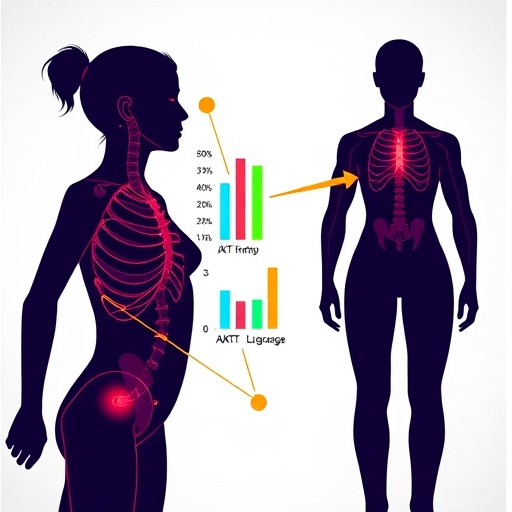In an era where scientific advancements are reaching unprecedented heights, understanding the intricate biological systems governing human health remains a cornerstone of research. A recent study led by Zhang et al. has focused on a particularly significant aspect of women’s health: polycystic ovary syndrome (PCOS) and its link with ovarian hyperandrogenism. This condition affects a substantial number of women globally and is associated with hormonal imbalances that can lead to various health complications. The findings reveal a critical axis involving AKT, LONP1, and STAR in the development of ovarian hyperandrogenism, shedding light on new potential therapeutic targets.
To comprehend the implications of this study, we must first delve into what PCOS entails. Polycystic ovary syndrome is characterized by irregular menstrual cycles, excessive androgen levels, and frequently, the presence of polycystic ovaries. The excessive production of androgens, often resulting from ovarian dysfunction, leads to a variety of clinical manifestations, such as hirsutism, acne, and infertility. As such, exploring the underlying molecular pathways that contribute to this condition is of utmost importance.
Using advanced techniques in single-cell transcriptomics, the researchers could analyze individual cell types within ovarian tissue, uncovering a wealth of data regarding gene expression patterns that are altered in hyperandrogenism. This analysis provides crucial insights into not only the cellular environment but also the regulatory mechanisms at play, particularly those involving the AKT pathway. The AKT signaling pathway, known for its role in cell survival, growth, and metabolism, has been implicated in various cancerous conditions but is less understood in the context of ovarian health.
The study highlighted the role of LONP1, a mitochondrial Lon protease, which contributes to cellular stress responses and metabolic regulation. Elevated levels of LONP1 have been associated with conditions that manifest metabolic dysregulation, further establishing its relevance in ovarian hyperandrogenism. When combined with the AKT pathway, the researchers identified a significant interaction that suggests a shared regulatory function in the context of ovarian function and dysfunction.
Moreover, the STAR protein, which facilitates steroidogenesis by transporting cholesterol into the mitochondria, emerged as another critical player in this axis. The balance of steroid hormones is vital for maintaining normal ovarian function, and dysregulation in STAR activity may contribute significantly to hyperandrogenism observed in PCOS patients. By recognizing the interplay between AKT, LONP1, and STAR, researchers hope to unveil potential targets for therapeutic intervention that could alleviate symptoms of PCOS.
One of the groundbreaking methodological advancements in this research is the application of single-cell transcriptomics, which allows scientists to dissect the complexities of cellular heterogeneity within the ovarian microenvironment. The ability to study gene expression at such a granular level enables rapid identification of critical genes and pathways implicated in disease processes—something that traditional bulk RNA-sequencing techniques could not achieve as effectively.
Furthermore, this study opens the floor for examining how environmental factors and genetic predispositions might influence these molecular interactions. The key finding concerning the AKT-LONP1-STAR axis not only deepens our understanding but also creates a roadmap for future research focused on therapeutic strategies aimed at modulating this pathway. For instance, pharmacological agents targeting this axis may offer novel treatment options for women suffering from PCOS and associated hyperandrogenism.
Understanding these mechanisms could transform the approach to managing PCOS, shifting from simply treating symptoms to addressing root causes based on individual biochemical profiles. It emphasizes the important synergy between precision medicine and gynecological health, illustrating how tailored interventions could pave the way for more effective management of this widely prevalent condition.
With this innovative research emerging from Zhang et al., there is optimism that similar approaches could be applied to other reproductive endocrine disorders. The ability to dissect cellular signaling pathways and their interconnections offers a clearer perspective on how we might tackle these multifaceted health issues systematically.
Although the implications of these findings are profound, they also raise questions about access to such advanced treatments. The translation of findings from bench to bedside is often fraught with challenges, including regulatory hurdles and economic constraints. Stakeholders in the healthcare and research communities must work collaboratively to ensure that promising discoveries lead to real-world applications that are accessible to all women battling PCOS.
In summary, the work led by Zhang and colleagues is not just a scientific entrance; it’s a hopeful beacon for women around the globe struggling with PCOS. By disarming the molecular machinery behind hyperandrogenism, the researchers have set the stage for developing targeted therapies that can profoundly impact women’s lives. As the research community continues to explore these pathways, it is crucial that both the scientific advancements and the resulting applications are communicated effectively to raise awareness and ensure women receive the care they deserve.
This study joins a growing body of literature that emphasizes the importance of understanding the biological intricacies behind diseases affecting women specifically. In this regard, it serves as a call to action for further research and funding into women’s health issues, ensuring they are prioritized in the broader scope of medical research.
Ultimately, the critical insights into the AKT-LONP1-STAR axis represent not only an advancement in our knowledge about ovarian hyperandrogenism but also an exciting direction for future research that holds the potential to change lives for the better.
Subject of Research: Ovarian hyperandrogenism in polycystic ovary syndrome (PCOS)
Article Title: Single-cell transcriptomics uncovering a critical AKT-LONP1-STAR axis in ovarian hyperandrogenism of PCOS
Article References: Zhang, C., Lin, Z., Lin, Y. et al. Single-cell transcriptomics uncovering a critical AKT-LONP1-STAR axis in ovarian hyperandrogenism of PCOS. J Ovarian Res 18, 275 (2025). https://doi.org/10.1186/s13048-025-01837-6
Image Credits: AI Generated
DOI: https://doi.org/10.1186/s13048-025-01837-6
Keywords: Polycystic ovary syndrome, hyperandrogenism, AKT pathway, LONP1, STAR, single-cell transcriptomics, women’s health, ovarian function, metabolic regulation.




